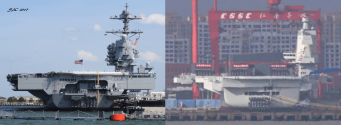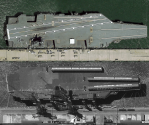The KJ-600 is not derived from the Y-7. It is a new platform redesigned.Besides, there has been no plan for an aerial refueling version of the Y-7 (of which the KJ-600 is derived from).
You are using an out of date browser. It may not display this or other websites correctly.
You should upgrade or use an alternative browser.
You should upgrade or use an alternative browser.
CV-18 Fujian/003 CATOBAR carrier thread
- Thread starter Jeff Head
- Start date
According to some commentators type 003 uses capacitors. Is using DC better than AC?
Yes DC is a superior to AC, I'm not familiar with the subject. looked up a random paper, DC has following advantages in ship board application:
1, No phase angle synchronization requirements between sources and loads
2, Facilitating the connection of different types of generators, storage and loads
3, Reducing fuel consumption due to the use of variable speed prime movers
4, Reducing the size and ratings of switchgears and cables and no need for the large low-frequency transformer
5, Elimination of frequency constraints from the design of generators and, as a result, reduction in their size and weight
As for capacitors VS flywheels, obviously capacitors is way simpler and more reliable than flywheels but has lower energy density. It also has better synergy with DC system since a flywheel system will be using induction motor/generator which involves AC in varying frequency depending on flywheel speed and a whole lot of frequency and phase manipulation, with DC system it's much simpler with IGBT's
I also wonders about flywheel's safety margins, a solid block of carbon fibre spinning at something like 40k rpm on a warship seems like a pretty risky point of failure...
Hi, guys, I tried to make some comparison pictures of Ford and Fujian, so that I can compare with the world famous aircraft carrier more intuitively.
But please note that the scales are not very accurate because I didn't measure them precisely.
So happy to be a part of here, logging in and browsing posts has become a daily requirement for me
Finally, good night and pleasant dreams everyone~



But please note that the scales are not very accurate because I didn't measure them precisely.
So happy to be a part of here, logging in and browsing posts has become a daily requirement for me
Finally, good night and pleasant dreams everyone~



Yeah Middle voltage DC is better. But it's hard to develop. USS Navy's ultimate goal is to using DC on ship, but right now they 're using AC on DDG1000 and Ford class. DDG1000 has a system transform AC into Low voltage DC, but also made the system even complicated.According to some commentators type 003 uses capacitors. Is using DC better than AC?
The Flanker is a superb aerodynamic platform, particularly when compared to the notoriously compromised Super Hornet design. In the naval realm the Flanker has been held back by lack of catapult launch enabling heavier payloads (including external fuel tanks for buddy tanking) and also by less sophisticated engine technology.
Once 003 and J-15T have resolved these issues, J-15 has a meaningfully higher performance ceiling than Super Hornet mostly because it is simply a larger aircraft, but also because it is a more aerodynamically sophisticated design. A fully-developed J-15 will have greater range and endurance than Super Hornet, better acceleration and top speed, generally better maneuvering characteristics, a larger and more powerful radar, and benefits from a large onboard IRST. Super Hornet will continue to feature in USN air wings at least until 2040 and the roles it will serve there as a complement to F-35B/C and eventually NGAD are the same roles J-15 will perform as a complement to the future J-31/J-35/J-XY aircraft. At comparable levels of development, Super Hornet's only performance advantage relative to J-15 would be its marginally lower RCS.
Yes. The advantage of Super Hornet, which it will retain in the near future, is that it has already been developed to a high level in terms of munitions compatibility, EW fitout and operation, buddy tanking, etc. J-15 has higher theoretical performance ceiling than Super Hornet, but that has yet to be achieved and will take some years to do so.
Can't wait to see the new J-15 taking off from 003 with beast mode.
A 4 Gen fighter full loaded with heavy missiles is much much much more sexier than a boring 5 Gen.
1. Further increase in power density of the power supply system, more flexible operation, higher reliability and easier to achieve regional isolation.Yes DC is a superior to AC, I'm not familiar with the subject. looked up a random paper, DC has following advantages in ship board application:
1, No phase angle synchronization requirements between sources and loads
2, Facilitating the connection of different types of generators, storage and loads
3, Reducing fuel consumption due to the use of variable speed prime movers
4, Reducing the size and ratings of switchgears and cables and no need for the large low-frequency transformer
5, Elimination of frequency constraints from the design of generators and, as a result, reduction in their size and weight
As for capacitors VS flywheels, obviously capacitors is way simpler and more reliable than flywheels but has lower energy density. It also has better synergy with DC system since a flywheel system will be using induction motor/generator which involves AC in varying frequency depending on flywheel speed and a whole lot of frequency and phase manipulation, with DC system it's much simpler with IGBT's
I also wonders about flywheel's safety margins, a solid block of carbon fibre spinning at something like 40k rpm on a warship seems like a pretty risky point of failure...
2. In AC systems, the generator speed is usually 3000 rpm due to the use of industrial frequency AC power, and a reduction gearbox must be installed between the prime mover and the generator. If switched to medium voltage DC, there is no longer any requirement for generator speed, and all gearboxes can be omitted, further reducing noise levels.
3. In AC systems, the frequency and phase of all grid-connected alternators must be matched, making it difficult to use prime movers with different speed regulation (e.g. diesel and gas turbines) in parallel. The use of MV DC can greatly reduce the difficulty of connecting different generators to the grid and further improve efficiency.
4.The grid connection of energy storage devices in the medium voltage DC regime is much simpler than in the AC regime, and the energy conversion efficiency is higher.
All governments especially superpowers in a cold war care about prestige.I think we need to get this ridiculous idea out of our heads that the Chinese government cares overwhelmingly about 'prestige', to the point where it would splurge billions of dollars, resources and manpower purely for the sake of it. It's a western stereotype implanted by MSM conveniently used to justify the million and one China collapse theories they come up with.
China building thousands of km of HSR? Prestige project. Not actually economically efficient. China gonna collapse soon.
China locking down entire districts after a few positive cases? Saving face. China gonna collapse soon.
etc
If anything, the CPC has consistently shown that it runs the country in a practical, sensible, logical, and resourceful manner.
I believe China is building supercarriers for the simple reason that as the largest trading nation in the world, China needs assets that can protect that trade.
Prestige means confidence from allies, and when there isn't any hot fighting, its all about posturing to discourage the other side from military adventurism. The other stuff you mention about say COVID or HSR is just about fulfilling the government's duty to provide for their popular base, not about international prestige.
As has been outlined many times, cutting edge weapons platforms largely make carriers obsolete. That will be true for Chinese supercarriers too once USA has developed similar capability.
I don't see China changing their whole doctrine to use CVs just like America. As for protecting trade routes, ofc China can get mileage out of CVs there too, but that's fairly low intensity.
But not as stealthy and the payload is much more varied in the F-35. J-20 can only do CAP loadouts.If you compare the J20 and F35 you get the same results. The J20 can fly farther, faster, and carries superior firepower.
But other countries’ ships have a main surface search radar too, so what would Type 364 have over those ships?
I do see that the Korean CIWS have fixed EO windows, whereas 1130 can rotate, but would EO search interfere with radar? There are on different wavelengths, no? I imagine it can’t be mechanical interference either since the LIG concept has the panels fixed to the turret body.
Excuse if this is slightly off topic, but since this system is unique to the Fujian at this moment, I figure it might give additional insights to the sensor suite.
Surface search radar is a luxury, as it calls for a second specialized search radar in addition to the main air search radar, and one thats only dedicated to scan for low flying threats. Such a radar needs to operate at a higher frequency band, like C or X, and it is optimized to discriminate targets better against sea clutter. Don't confuse this with volume air search radars that's optimized for range and volume, good for detecting aircraft at long ranges, but may have clutter issues when their beams are close to sea surface. Sea skimming anti ship missiles take advantage of sea clutter's causing reduced efficiency of search radars, reducing detection.
For these to operate, the main large air volume search radars are scanning for bombers and other threats at far greater ranges and altitudes, while the surface search radar is simultaneously scanning for low flying threats at the edge of the radar horizon. Its not a navigation radar, which although can also detect and track low flying threats, don't have the range for it. The navigation radars coexist with the surface search radars.
